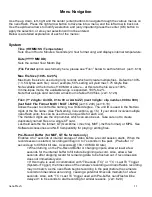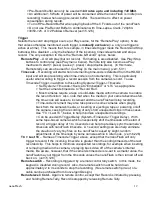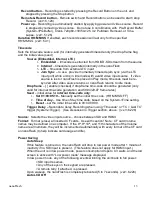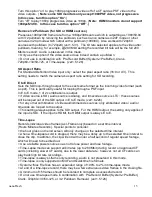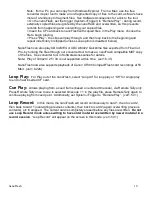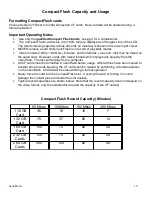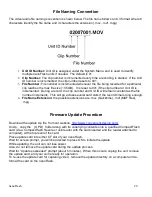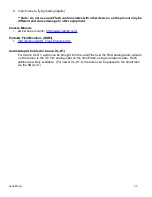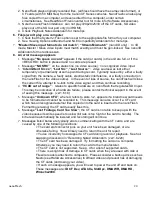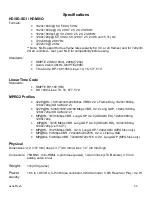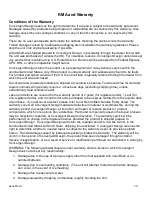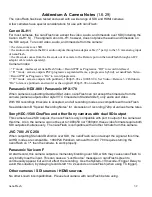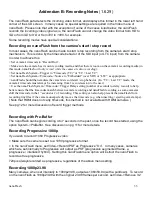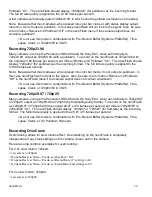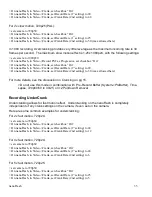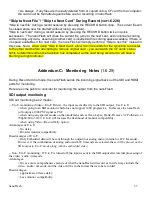
2. NanoFlash plays originally recorded files, (all files should have the same video format), or
CF cards (with 50 Mbit files) from the Canon XF Series cameras. NanoFlash can also play
files copied from a computer, and even edited from a computer, under certain
circumstances. See ReadMe of FileConverter tool for more info (Software Accessories).
3. Note the nanoFlash limitations: can not play 720p24/25/30 off the CF cards, SD video
plays out of the SDI out port only (not HDMI).
4. Check Playback Notes Addendum for more tips.
6. File(s) won't play on a computer
1. Check that the System->File= option is set to the appropriate file format for your computer.
2. See Viewing Options Addendum and NLE Compatibility Addendum for more tips.
7.
“Master/Slave input formats do not match”, “Stream Mismatch”
(nano3D only) : In 3D
mode, Master / Slave video inputs must match exactly, and must be gen-locked. See nano3D
Addendum for more discussion.
8. An error message appears
1.
Message
“No space on card”
appears if the card (or cards) in the unit are full, or if the
<RECORD> button is pressed and no cards are present.
2.
Message
“NO SRC”
on the status line (no video source): no recognized video input.
3.
“
Intermittent Src xx”, “Lost Src”, “Lost Source”
: video source was lost either
temporarily or permanently at some point during record. Typically caused by either a faulty
signal from the camera, a faulty cable, electro-static interference, or a faulty connector (on
the nanoFlash or the video source). In the event of loss of source, the nanoFlash will close
the current file, attempt to re-lock to the video signal, and then continue recording.
4.
“
VCXO out of range”
: relates to specific hardware on nanoFlash that regulates SDI input.
This may be indicative of a hardware failure; please contact technical support in the event
of seeing this message. (ver1.6.18)
5.
Message
“Unknown CFX”
, where X refers to slots 1-2, appears if a brand new card needs
to be formatted and cannot be recorded to. This message can also occur if a CF card
which has unrecognized external files copied onto the card is inserted to the nanoFlash.
Formatting (erasing) the CF card usually fixes this.
6.
Message
“Lost Footage, Card Too Slow”,
the CF card is not able to keep up with the
video because its write speed is too slow (bit rate is too high for the card to handle). The
bit rate will automatically be lowered and recording will continue.
7. Messages listed below are typically errors communicating with the CF cards, and are
caused by one of the following conditions:
> The card slot connector pins on your unit have been damaged, or are
otherwise failing. You will likely need to return the unit for repair.
> You've incorrectly hot-swapped a CF card during record or playback. See hot-
swapping discussion in “Recording Notes” Addendum. (ver1.6.226)
> The CF card has been damaged. Try formatting the card on a computer.
Otherwise you may need to return the card to the manufacturer.
> The CF card is not supported. See p. 4 for a list of supported cards.
> There is a slight risk of damage to CF cards when they are used with Usb or
Firewire readers attached to computers. Please consider a backup drive such as
Nexto (see Hardware Accessories) to offload video and prevent risk of damaging
the CF cards (and losing your video).
> If such a message appears, you will need to power the unit off and back on.
These messages are:
ID CF Dev, ATA Idle, SlotDpc, DMA WR, DMA RD,
Wrcache2000
.
nanoFlash
24


